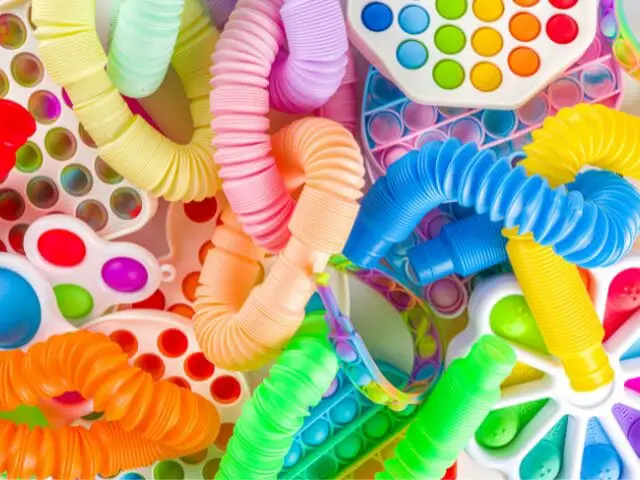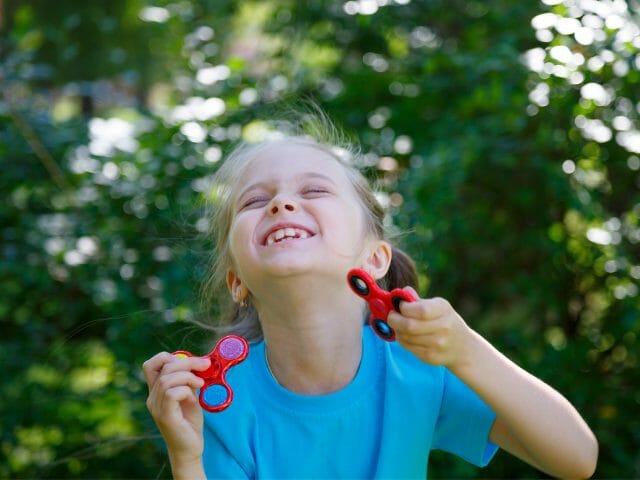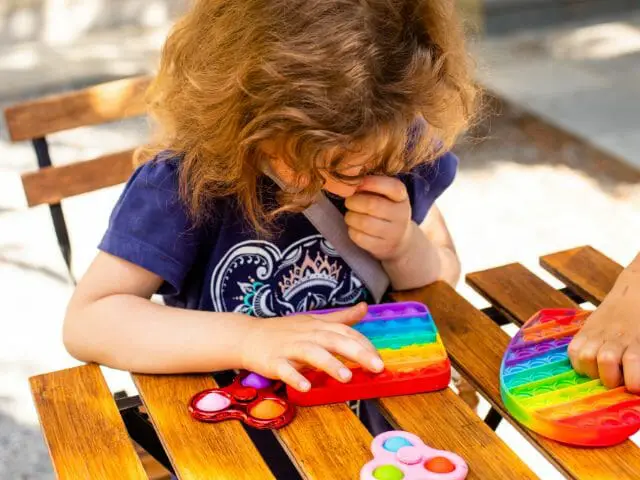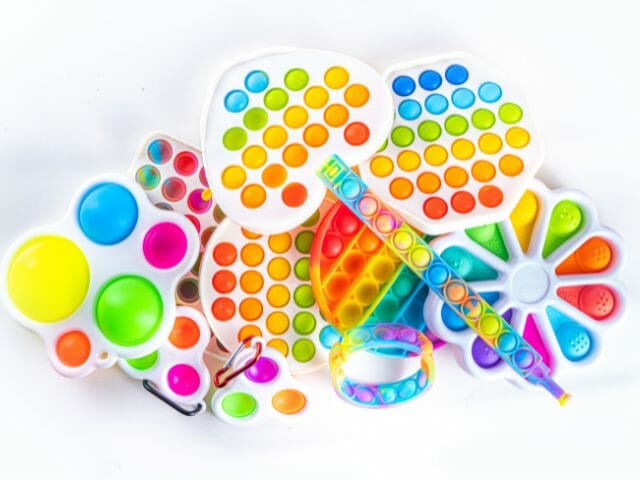If adults fidget several times during the day, why would we expect less from children? Fidgeting are those small hand or foot movements we make when impatient, nervous, or bored.
What can be the reason?
Children are prone to fidgeting since they have to spend several hours in a school setting. This creates the need for fidgeting toys.
Fidgeting toys help learners focus on play, leisure, and academics.
Fidgeting toys also help students with sensory disorders maintain focus. They have contributed to better focus among children with Attention Deficit Hyperactivity Disorder.
This article explains in detail what fidgets are and how to successfully introduce fidget toys in a classroom.
What Are Fidget Toys?

Fidget toys are designed to promote self-regulation and movement while encouraging listening and active learning in classrooms with diverse learning styles.
These toys help students focus on reading, listening, or communication while keeping their hands, feet, or mouth active.
Due to their purpose, fidget toys are also known as fidget tools, concentration tools, sensory gadgets, and sensory tools. They come in different textures, sizes, and shapes. Students manipulate the fidget tools in their hands or feet to make small movements.
Fidget toys may feature simple or complex designs. Since they look like toys, they can be distracting in a classroom setting, especially in elementary school.
This is why it would be best to refer to them as ‘fidget tools’. This way, they will become more meaningful and impactful.
What Type of Students Can Benefit From Using Fidget Toys?

Every class has one or more restless students who visit the bathroom frequently, move around the classroom, or are constantly quenching their thirst. The inability of these students to sit skills during the classroom lessons often leads to unfinished assignments, knowledge gaps, and skill gaps.
These learners have high energy pent up within them.
Sensory integration and movement have proved to control a restless body to facilitate learning.
Other students may showcase their sensory needs by chewing their clothes or nails or scratching their scabs. Fidget toys help calm the body while the mind stays alert and focused.
Fidget tools can also help learners with anxiety, autism, and Attention Deficit Hyperactivity Disorder (ADHD).
The sensory tools act as a movement outlet to enable the child to focus better.
Movement allows the right and left parts of the brain to be active, thereby promoting learning. The higher the sensory input the brain receives, the better the nervous system self-regulates.
How To Successfully Introduce Fidget Toys In A Classroom

Fidget tools may be considered distracting by some parents and teachers. However, it all comes down to how you introduce fidget toys to your students. The introduction can be successful if you do so in an organized and thoughtful way.
Here is a guide on how to introduce fidget tools in a classroom.
Introduce The Sensory Systems
Your students may be familiar with the five common senses: touch, sight, hearing, smell, and taste. Now, it is time to teach them the two additional sensory systems; vestibular and proprioceptive. The Inspired Treehouse calls them the Magic7 senses.
These sensory systems are mainly involved with movement and balance. The vestibular system enables us to stay upright and helps us understand the position of our body in relation to space.
On the other hand, the proprioceptive system helps the brain coordinate the force of our movements as well as body part awareness. This is the sense that allows us to move freely and performs actions without conscious thinking.
After explaining the sensory systems, allow your students to experiment with various sensory inputs and explore different sensory stations.
Identify Your Learners’ Sensory Preferences

Next, help your kids explore their individual sensory preferences. Help them discover their own unique sensory needs based on the sensory experiences they love and hate.
Take time to make your learners understand that their sensory aversions are normal when they do not interfere with life. Teach kids that individuality and uniqueness are part of being normal.
When students identify their sensory needs, discuss what they think can help them become more attentive and focused in class or stay calm. This discussion should be lively and engaging, whether you are a teacher, counselor, or occupational therapist.
Generate A Classroom Sensory Kit
At this point, you have identified your learner’s sensory preferences. Now, create a list of those items you need for your classroom sensory kit. These sensory tools should be geared toward meeting the unique preferences of your students.
Here are different types of fidget tools you could add to your classroom.
|
|
|
|
|
|
|
|
|
|
|
|
|
|
|
|
|
|
|
|
The goal is to have several items for kids having trouble concentrating, remaining calm, and sensory processing issues.
Involve Your Students In Creating Fidgets

When generating a sensory kit, ask your learner to chip in. Kids feel a sense of responsibility, accomplishment, and ownership when they help create or assemble sensory materials. Moreover, creating tools allows your students to work together on hands-on activities.
Once you have completed the project, assign the students to label and organize the sensory processing tools at a suitable location in the class.
Jump In: There are many variations of this toy and costs a lot cheaper, too! Follow this article and find out how to make one — DIY Fidget Toys: 27 FUNtastic Out-Of-The-Box Ideas To Try!
Fun Fact: If you think that introducing fidget toys are disadvantageous to your students, then you can divert their attention to planting instead. This is more relaxing and it promotes a healthy mindset. I wrote an article specific to this topic — 

Describe Fidget Toys As Tools
When you hand a fidget to a student, their first reaction will be to play with it. For instance, if you introduce stress balls, the students may initially toss or throw them.
Since this is not the behavior you are looking to nurture, it is best to explain these fidgets are meant for learning, not playing.
Help your students learn that the tools are intended to aid the learning process rather than distract.
Establish A Sensory Toolkit Contract

You need to set some ground rules for fidget tools to be effective. Be clear that failure to follow the set guidelines may see them lose the privilege of using the sensory tools.
Also, differentiate those tools that can be used during class hours and those distracting yet perfect for break times. Acknowledge that the fidgets are meant for sharing, and everyone has a right to access them.
Here are great tips on how you can formulate your sensory kit contract.
- Only ask for a fidget tool when you need it.
- Raise your hand if you need a fidget tool during class hours.
- Take good care of the assigned fidget tool.
- Do not distract others with your fidget tool.
- Do not throw, bounce, or drop fidgets.
- Return the fidget tool to the designated area after use.
- Use break-time fidget tools during breaks and take turns.
Your classroom contract guidelines should match your learners’ needs. Once you have finished drafting the contract, print a copy and post it on the wall.
Address Any Questions
Every classroom features some students who need fidgets to promote classroom learning. When you grant these students access to the freedom to use fidget tools during learning time, your decision may raise questions from their peers.
What can you do? We recommend you reinforce the concept of individuality and uniqueness. Explain that different students need different materials to learn.
Illustrate by showing them how some students need glasses to improve their vision. Similarly, help your learners understand that fidgets are tools that help fidgeting learners concentrate better.
What Are The Best Fidget Tools For Sensory Input?

They could be fine motor, gross motor, or oral motor tools.
When choosing a fidget for wiggling, fidgety hands, or bouncing feet, ensure it checks these boxes.
- It is quiet.
- It is safe.
- It is durable.
- It does not distract the student during the lesson.
- It matches your student’s needs, particularly the texture.
- It meets the physical ability of your student.
Fidgets In The Classroom: Fad Or Bad For Kids At School?
Fidget spinners were a craze back in 2017. But, as great as they are, they are not ideal for a classroom. A fidget spinner commands attention from the student when doing tricks or spinning.
Moreover, fidget spinners do not create a positive environment because students have trouble sharing or taking turns. Besides, some are noisy.
And before we get this into a wrap, watch this YouTube video on how to use fidgets:
Final Thoughts
Whether you are a teacher, guidance counselor, or school psychologist, introducing fidgets in the classroom can help students focus, particularly those with sensory processing challenges.
Fidget tools provide touch input and movement, two powerful components for focusing and paying attention. These concentration tools help learners stay calm and self-regulate their movements.
When incorporating fidgeting tools in your classroom, ensure that they meet your student’s preferences. Also, create a contract that explains how learners should interact with these tools.
Last Updated on July 24, 2022 by Emily
- Facebook9
- Twitter21
- Pinterest67
- 97shares






